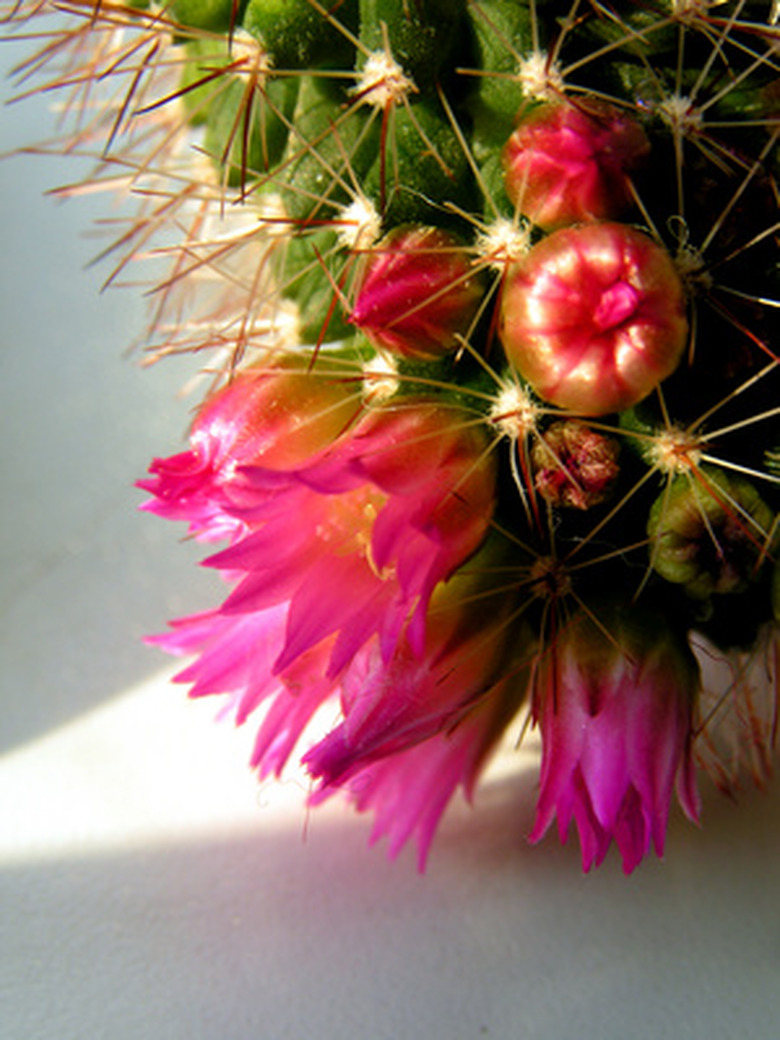How To Care For Orchid Cactus Plants
Things Needed
- Liquid houseplant fertilizer
- Pruning shears or scissors
- Planter pots
- Well-draining potting mix
- Ground bark, grit or perlite
- Humidifier or water spray bottle
The orchid cactus (epiphyllum hybrid) is a flowering plant that's native to Central America. Orchid cactus has fleshy, succulent-like stems, and it is most commonly grown indoors as a houseplant due to its sensitivity to cold. The orchid cactus blooms in large, showy, bright-colored flowers, typically from April through July. Orchid cactus plants can take up to four years or more before they begin to flower. The fleshy leaves and stems are attractive, however, and create an interesting plant even without the flowers.
Step 1
Position your orchid cactus in filtered sunlight, where the plant receives bright light in the morning and has some shade in the afternoon.
Step 2
Water your orchid cactus from March until mid-October to keep the potting soil evenly moistened. When the topmost layer of soil begins to feel dry to the touch, pour water until the water drains from the drainage holes in the bottom of the pot. Discard the excess water from the drainage dish.
- The orchid cactus (epiphyllum hybrid) is a flowering plant that's native to Central America.
- Orchid cactus has fleshy, succulent-like stems, and it is most commonly grown indoors as a houseplant due to its sensitivity to cold.
Step 3
Reduce the watering frequency gradually beginning in mid-October. Water your orchid cactus during winter to keep the soil barely moistened, but don't allow the soil to dry out.
Step 4
Fertilize your orchid cactus once every two weeks from early spring until early fall. Apply a liquid houseplant fertilizer with a nitrogen-phosphorous-potassium (NPK) ratio of 5-1-4, according to the dosage instructions on the label.
Step 5
Induce flowering of your orchid cactus by keeping the plant in total darkness at night during the winter, with no exposure to artificial light. Keep the nighttime temperature cooler around the orchid cactus, about 50 degrees Fahrenheit but no warmer than 57 degrees.
Step 6
Prune away older nonflowering stems and any damaged stems. Cut these stems back to the base of the orchid cactus to prevent the cut stems from producing new, unsightly shoots.
- Reduce the watering frequency gradually beginning in mid-October.
- Induce flowering of your orchid cactus by keeping the plant in total darkness at night during the winter, with no exposure to artificial light.
Step 7
Repot your orchid cactus after it has produced three to four new branches or when the plant is top-heavy and begins to tip over when you move it. This is usually every three or four years. Repot the orchid cactus in a container that's the next size up, and don't water the plant for about one week after repotting it. Repot the orchid cactus after it has finished blooming.
Tip
Pot your orchid cactus in a container that has drainage holes in the bottom. Plant the orchid cactus in a well-draining commercial potting mix, preferably one that is coarse in texture. You can mix into the commercial potting mix some ground bark, grit or perlite to improve drainage.
Warning
Don't allow the air to become too dry around your orchid cactus, because it needs relative humidity of 50 to 80 percent. When conditions are drier, you can increase humidity around the orchid cactus by running a humidifier beside it or by misting it with warm water.
